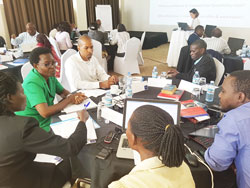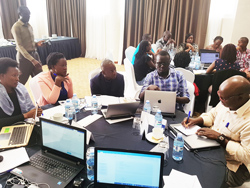Over 50 stakeholders have been equipped with skills to design and implement the mitigation hierarchy as a planning and management tool for biodiversity conservation.
Wildlife Conservation Society (WCS) in partnership with Forest-Trends and Biotope, and the University of Oxford organized a training workshop for Environmental and Social Impact Assessment Consultants, NEMA and UEGCL staff, and others from the private sector from 25th - 28th June 2018 at Skyz Hotel, Naguru in Kampala.
Then training session covered four modules: Introduction of the mitigation hierarchy, Designing and Implementing biodiversity offsets and methods of assessing biodiversity offsets using Isimba Hydropower project in Kayunga district as a case study and the Social aspects of biodiversity offsets.
The mitigation hierarchy is a series of essential, sequential steps that are taken throughout the project’s life cycle by users as a tool towards limiting the negative impacts on biodiversity from development projects. It emphasizes best-practices of avoiding and minimizing any negative impacts, and then restoring sites no longer used by a project, before finally considering offsetting residual impacts. When used properly, the process ensures that development results in No Net Loss (NNL) of, or a Net Positive Impact (NPI) on biodiversity.
The Country Director, Wildlife Conservation Society, Simon T. Nampindo who also facilitated the workshop said, “In light of the current and proposed developments in Uganda’s biodiversity hotspots, ESIA professionals, project developers, private sector companies and financial institutions who are required to apply the mitigation hierarchy during project design and implementation to avoid damage to biodiversity and the environment must fully grasp the mitigation hierarchy concept and the legislative and regulatory framework that supports it to balance conservation needs with development priorities.”
The current rapid scale and magnitude of developments in Uganda, particularly large infrastructure projects are putting pressure on biodiversity and the people who depend on it for their livelihoods and well-being.
Biodiversity refers to the variety of life forms on earth: the different animals, plants and micro-organisms, their genes and the ecosystems of which they are part. Biodiversity provides beneficial ecosystem services to humankind, including oxygen production, soil formation, water purification, climate stabilization, pollination and waste decomposition.
Uganda’s rich biodiversity is being lost at a greatly accelerated rate due to human activities. The demand for energy; food; water; mineral exploration; oil and gas development; infrastructure and a growing population with expanding consumption levels are threatening the ecosystems that business and people depend on. WCS is concerned that if no environment and social safeguards are embedded in the project design and implementation to secure the health of lands and waters for future generations, huge risks associated with loss of biodiversity, ecosystem services and the irreversible transformation of landscapes in Uganda will become costly for the country. It will exacerbate the poverty levels due to the collapse of business that heavily depend on ecosystem services and subsequent loss of jobs, increase in disease outbreaks and disruption of predator-prey dynamics will expose agriculture to unbearable negative effects.
Development projects in the pipeline include: Oil and gas exploration and production in the Albertine rift of endemism (a biodiversity hotspot) that will have a 1400 km crude oil pipeline exporting oil from western Uganda to the coast to the Tanga port in Tanzania; the proposed standard gauge railway set to run through nine (9) central forest reserves and over five hydropower projects under construction including the Karuma, and Isimba power plant on the Nile that is being built close to an existing hydropower site at Bujagali and the oil roads. The increasing demand for industrial agriculture such as sugar cane, maize and livestock ranching in the Karamoja region and Uganda’s population growth rate currently estimated at 3.6% per annum that exerts a high demand on natural resources for charcoal, fisheries and bush meat are expected to have direct, indirect and cumulative negative impacts on the Ecosystems that could lead to extinction of various species.
Some of the projected negative impacts cited during the training included: fragmentation and decimation of living organisms and their habitats; disruption or blockage of dispersal or foraging routes; increased poaching and other illegal activities; killing of slow moving animals such as tortoises or snakes; offsets gone bad; behavioral disruption of wildlife attributed to seismic waves, noise and night light and at worst extinction of species and plants.
“Good biodiversity practice goes beyond a traditional environmental and social impact assessment; it considers the wider landscape; the direct; indirect and cumulative impacts; identifies key biodiversity values; supports ecological processes and ensures the rigorous application of the mitigation hierarchy,” said Dr. Malcolm Starkey, the Technical Director at The Biodiversity Consultancy Ltd
Starkey, a facilitator of the workshop said living natural capital is being eroded fast and the benefits that come with it and therefore applauded the government, business and finance representatives converging on a ‘no net loss’ approach to biodiversity and ecosystem services.
Regarding Social No Net Loss, the facilitator of the module, Dr. Julia Bakers that works with Balfour Beatty said that offsets should achieve no net loss of biodiversity with respect to species composition, habitat structure, ecosystem function and the people’s use and cultural values associated with biodiversity. She cited the people’s ability to still collect firewood, medicinal plants and access cultural sites for both their survival and social cohesion even after the project is ended.
“The project-affected people should perceive their wellbeing to be at least as good as a result of the development project and associated biodiversity offset, throughout the project lifecycle, than if the development had not been implemented,” she said.
But to measure No Net Loss, there should be an aggregate measure of the people’s wellbeing something that is not yet fully explored; a level that Social No Net Loss can be measured at and a baseline against which to compare and measure No Net Loss. Unfortunately, there is no detailed guidance on achieving social outcomes from no net loss or what social outcomes to achieve so far.
Though Uganda has drafted the Wildlife and National Environment bills which make provisions for No Net Loss of biodiversity, international guidelines on No Net Loss do not contain specifics on social considerations.
On Natural capital which is the stocks of natural assets that include geology, soil, air, water and all living thing, Julia said there is need for stock taking of natural capital, identifying their value and benefits to society while using the no net loss or net positive impact approach to ensure wholesome economic development and natural capital conservation.
Though natural capital accounting is now widely promoted as a policy support tool for achieving better management of natural capital, and an increasing number of forest, land and water accounts are being developed in Uganda in response to policy demands, the value and benefits from natural capital cannot be fully accurately quantified even when the environment and social impact assessment process is meticulously followed.
It is from this natural capital that humans derive a wide range of services, often called ecosystem services, that make human life possible.
Dr. Hedley Grantham, the Director Spatial Planning, Wildlife Conservation Society, Australia; Jan-Willem Van Bochove, the Senior Principal Consultant at The Biodiversity Consultancy Ltd (TBC), Dr. Malcolm Starkey, the technical director also from TBC, Dr. Julia Baker of Balfour Beatty facilitated .
National Environment Management Authority(NEMA), Uganda Association for Impact Assessment (UAIA), Total E&P, China National Offshore Oil Corporation(CNOOC), National Bio-diversity Data Bank (NBDB), Environmental Resources Management (ERM), Uganda Electricity Generation Company Limited(UEGCL), Enviro-Care and Management Limited (EIMCO), JMR Consult, EMAN Consult and Parliament were the institutions part of the training workshop.
Despite its small size, Uganda is one of Africa’s richest countries for biodiversity known to support 1,742 terrestrial vertebrate species (with more than half of Africa’s birds), and at least 3,662 plant species among others.
Conservations, impact Mitigation and Biodiversity Offsets in Africa normally referred to as the COMBO Project aims to reconcile economic development in Africa with conservation of biodiversity and ecosystem services.

